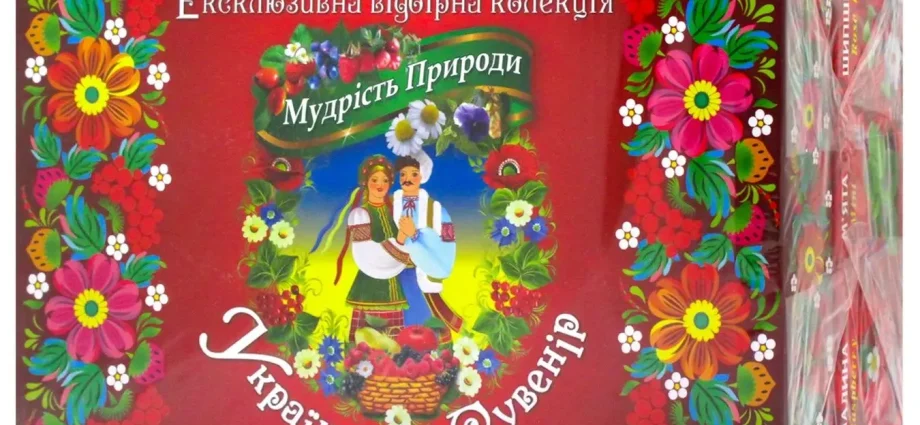Contents
Remontant raspberry Polesie was bred in Poland in 2006. The variety is intended for farms and personal subsidiary plots. The popularity of raspberry Polesie is explained by its unpretentiousness, productivity and affordable cost of planting material. When growing a variety, the place of planting, natural light, the flow of moisture and nutrients are important.
Features of the variety
Description of the raspberry variety Polissya:
- repair look;
- early maturation;
- harvest from late July to early October;
- moderate raspberry growth;
- medium plant;
- raised bush;
- height up to 1,3 m;
- straight branches;
- a few soft spikes;
- leaves narrow, wrinkled.
Characteristics of Polesie berries:
- large raspberries;
- weight 6-10 g;
- heart-shaped;
- dark red;
- subtle aroma;
- weak pubescence;
- a small light coating;
- dense pulp;
- sweet and sour taste.
Productivity from a bush grade Polissya – up to 4,5 kg. Ripe berries are recommended to be removed regularly. With a long stay on the shoots, the fruits darken.
Variety Polissya is used for cultivation in garden plots and farms. Jams, jams, compotes are prepared from berries. Fruits are highly transportable, suitable for freezing. Overripe berries should be processed faster, their shelf life is limited.
The frost resistance of the Polissya variety is assessed as high. Plants tolerate frosty winters under snow cover. In its absence, additional shelter is required.
Planting raspberries
Raspberries Polissya are planted on a suitable site. When choosing a place for growing a variety, light, soil composition, and groundwater location are taken into account. Seedlings are bought from trusted suppliers or obtained independently from the mother bush.
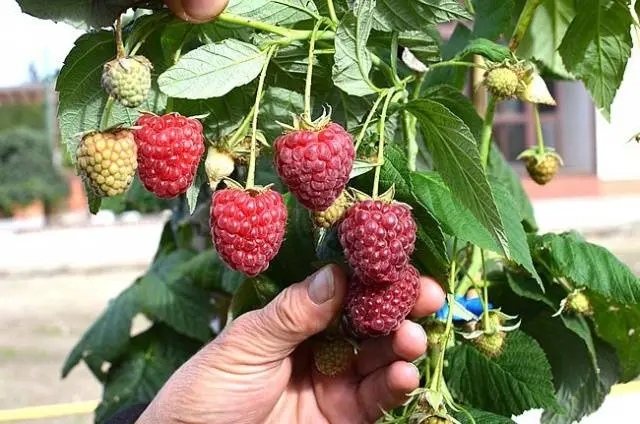
Breeding varieties
When buying a seedling of raspberry Polesie, the root system is evaluated. In strong bushes, the roots do not have defects and are not overdried, there are buds on the shoots. The thickness of the shoots at the base is about 5 cm, the height of the plant is 30 cm.
Remontant raspberry seedlings are obtained independently in one of the following ways:
- root suckers;
- cuttings;
- division of the bush.
The Polesie variety is characterized by a slow formation of shoots. Most planting material can be obtained from bushes at the age of 4-5 years.
In summer, root shoots up to 10 cm high are selected. They are dug up and transferred to a separate bed. Plants are regularly looked after: watered, fed, protected from the sun. After rooting, the bushes are transplanted to a permanent place.
To propagate the Polissya variety, raspberry rhizome is dug up with cuttings in autumn and cut into strips 10 cm long. The cuttings are buried in a trench, watered and mulched the soil. The following year, sprouts will appear, which are watered and fed all season. In autumn, raspberries are ready for planting in a permanent place.
Remontant varieties are grown in one place for no more than 12 years. When transplanting, the bushes are divided to obtain new plants. Sections are treated with charcoal.
Site Preparation
Remontant raspberries are demanding on the place of cultivation. Under the raspberry allocate a site well lit by the sun and protected from the wind.
In the southern regions, the Polissya variety is provided with partial shade. Under the constant influence of the sun, the berries are baked, losing their external and taste qualities.
Groundwater must be at a depth of more than 1 m so that the root system is not affected by them. For planting raspberries Polesie choose a site located on a hill or with a slight slope.
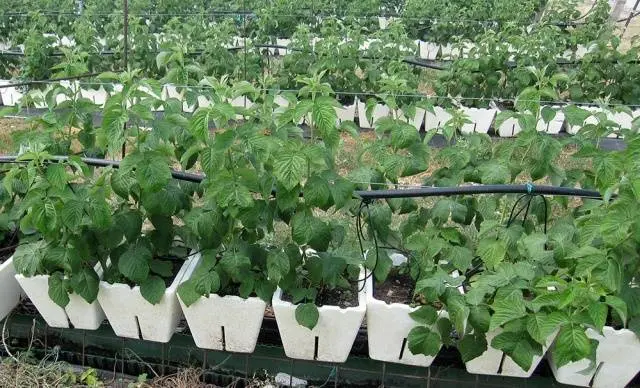
Before planting Polesie raspberries, it is recommended to grow mustard or lupins on the site. 1-2 months before the work, the plants are buried in the ground. Green manures enrich the soil with nutrients.
Instead of green manure, when digging the soil, 3 buckets of compost per 1 sq. m. From mineral fertilizers add 200 g of complex fertilizer containing potassium and phosphorus.
Order of work
Raspberries of the Polissya variety are planted in the fall at the end of September or in the spring before bud break. The sequence of work does not depend on the timing of landing.
The procedure for planting raspberries Polissya:
- Preparation of planting holes 50 cm deep and 45×45 cm in size. 70 cm are left between the bushes.
- The roots of the seedling are lowered for 2 hours in a growth stimulator.
- The plant is placed in the planting hole. The root neck is left, the roots are sprinkled with earth.
- Raspberries are watered abundantly.
- The soil is mulched with humus.
Young plants need special care. As the soil dries out, moisture is added. For the winter, raspberries are insulated with a covering material.
Variety care
Polissya raspberries are cared for by watering and fertilizing. To get a good harvest, cut off the shoots. Preventive treatments will help protect plantings from diseases and pests.
Polesie raspberries are grown without tying, if the plants are not exposed to wind and rain. To organize the support, several metal or wooden planks are installed. Two levels of wire are pulled between them.
Watering
According to reviews, Polesie raspberry is sensitive to lack of moisture. Its deficiency leads to a reduction in the number of ovaries, wilting of leaves and fruits.
When watering, it is important to ensure that moisture does not stagnate in the soil. The soil should get wet to a depth of 40 cm. Morning or evening time is chosen for irrigation.
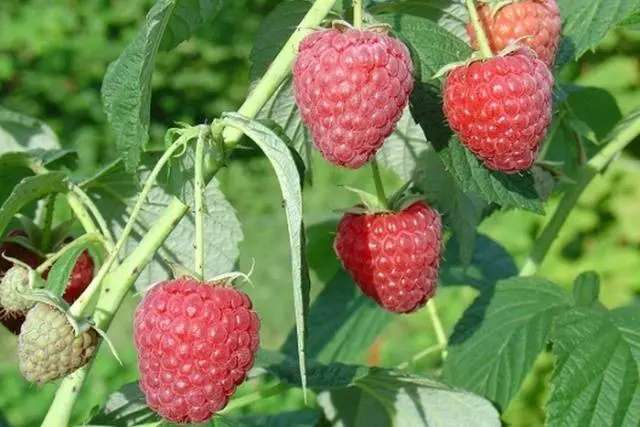
On average, Polissya raspberries are watered every week. In drought, moisture is applied more often; in rainy weather, you can do without watering.
After watering raspberries Polissya perform loosening. Plant roots will get access to oxygen and will better absorb nutrients.
Feeding
After planting, when fertilizing, Polesie raspberries begin to be fed in the third year. In early spring, plants are watered with a solution of mullein in a ratio of 1:20. The fertilizer is enriched with nitrogen, which promotes the emergence of new shoots.
Throughout the season, Polissya raspberries are fed with minerals:
- 50 g superphosphate;
- 40 g of potassium sulfate.
There are intervals of 3 weeks between procedures. When it gets cold, spraying is carried out so that the raspberries quickly absorb the nutrients. For leaf processing, the fertilizer content is reduced by 2 times.
In autumn, wood ash is scattered between rows with raspberries. The fertilizer contains potassium, calcium and other trace elements.
Trimming
In autumn, Polesie raspberries are recommended to be cut at the root. Then in the summer they get one plentiful harvest, the likelihood of the spread of diseases is reduced.
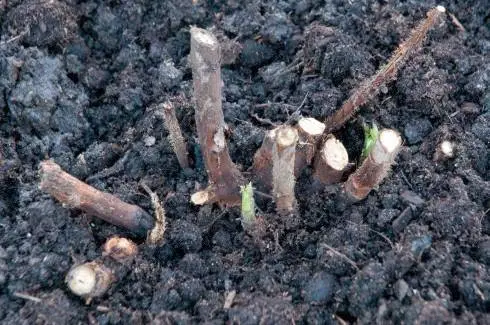
Pruning allows you to maintain the viability of the bush. In the spring, new branches will grow, on which the crop will ripen.
If one-year-old shoots are left, then the bushes can be harvested twice per season. With this treatment, the plant is subjected to increased stress.
Diseases and pests
According to the manufacturer’s description, the Polissya raspberry variety is characterized by medium resistance to diseases. With the observance of agricultural technology and proper watering, the risk of developing diseases is minimized. The choice of high-quality material for planting and the disinfection of garden tools helps to protect the site from diseases.
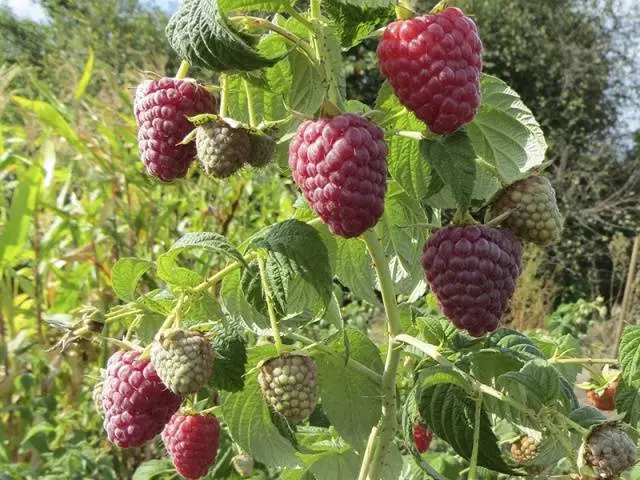
Raspberries are attacked by aphids, weevils, beetles, caterpillars, gall midges. Pests are carriers of diseases and cause direct damage to plantings.
Chemicals are used against insects. Raspberries are processed before bud break and in late autumn after harvest. For the prevention of diseases, Bordeaux liquid, a solution of the drug Nitrafen or Karbofos are prepared.
For preventive purposes, planting raspberries is treated with an infusion of onion peel, garlic, and tansy. Plants are sprayed on the leaf.
Reviews of gardeners
Conclusion
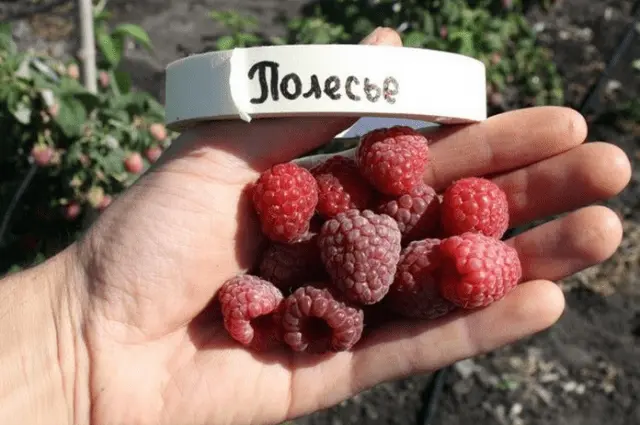
Raspberry Polesie brings an early harvest of tasty and fragrant fruits. The berries are large, have a good taste and are stored for a long time. The variety is suitable for industrial cultivation and planting in private gardens.
Raspberry care Polissya includes watering and fertilizing, the shoots are pruned for the winter. To preserve the commercial qualities of berries, their timely harvesting is required. Fruits have universal application, suitable for processing and fresh consumption.










